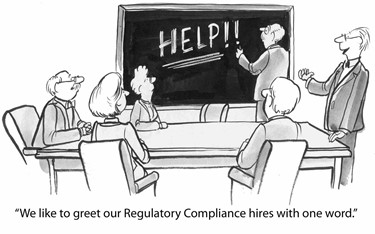FDA Registration for CMOs – Still Crazy After All These Years

By Bob Marshall, Chief Editor, Med Device Online

Let’s face it: manufacturing in a regulated environment is more expensive than commercial manufacturing. With all due respect to the venerable prowess of medical device manufacturing professionals, even a lean, mean, 5S, Six Sigma, 8D machine cannot offset the cost created by a plethora of requirements, guidance documents, and standards.
Regulation includes additional documentation, at the least, and in most cases involves additional formal training, testing, qualification, validation, certification, risk management, complaint handling, and on and on. Medical device OEMs are well aware of this. They all must register their establishments with the FDA and abide by the medical device requirements within the Code of Federal Regulations (CFR).
So, what happens when a medical device OEM decides to outsource the manufacturing of one or more devices from its product line? Quite naturally, the OEM expects that the contract manufacturing (CM) partner will do everything the OEM would do in-house, except better, and less expensively. Does that happen?
In many cases, the answer is yes. Supply chain management and partnering arrangements have proven quite successful at ironing out the proper relationship to successfully outsource medical device manufacturing. But, if that is the case, why did a medical device CM say to me, just a few weeks ago, “we are just making parts for [the medical device OEM]. We make quality parts, but all of that regulatory paperwork is on [the OEM].”
Stop the presses! Wait, do we still have presses? No? Okay, stop pressing the keys! What planet is this guy on? This contract manufacturer was manufacturing and assembling a complete, functional, electro-mechanical device used to diagnose a specific disease in humans for a medical device OEM. Granted, the device and its labeling bore the OEM’s name, and the contract manufacturer was not commercially distributing the finished devices, but the products they were manufacturing fit the definition of a medical device (per the FDA) and were, in fact, FINISHED DEVICES!
I searched for the contract manufacturer on FDA’s registration database and could not locate them. As much as I partially fault the CM for being irresponsible and failing to recognize what they must do to manufacture medical devices, my more prominent question is, how did this get past the OEM’s supplier qualification process?
Unfortunately, this case is not unique, or even all that peculiar. We have had confusion regarding each party’s responsibilities in outsourced medical device manufacturing arrangements for the last two decades.
Current Requirements For Medical Device Contract Manufacturing
The most recent changes to establishment registration and device listing affecting medical device CMs occurred in October 2012. Per that change, “All contract manufacturers and sterilizers of finished devices must register and list regardless of whether they put the device into commercial distribution or return the device to the manufacturer or specification developer.”
Two important supporting definitions: In this context, what is a “contract manufacturer,” and what is a “finished device?” In defining who must register and list, the FDA defines a contract manufacturer as “(one who) manufactures a finished device to another establishment's specifications. Providing further clarification, 21 CFR 820.3(l) states, “Finished device means any device or accessory to any device that is suitable for use or capable of functioning, whether or not it is packaged, labeled, or sterilized.”
A Historical Source Of Confusion
Part of the cause for lingering confusion is the fact that requirements have changed significantly, several times, over the past 20 years. When I went to work for a manufacturing company that wanted to become a medical device CM in 2000, the requirements were different. CMs had the option to register their establishments with the FDA. When CMs did choose to proactively register, it often was a marketing gesture, and they would advertise themselves as “FDA-registered.” Sometimes, OEMs would request that a CM register with the FDA as a condition of its contract. The only real difference, was technically, the FDA would have the CM on its potential inspection list. However, it was rare for a CM to get a routine inspection without any cause; the priority to visit each OEM location at least once every two years kept the FDA field investigators more than busy.
The landscape shifted again about five years later when the FDA changed establishment registration requirements for CMs, dictating that a CM only could register if it directly distributed a finished medical device to the commercial market. In this era, the FDA was placing the burden to directly monitor CMs on the OEMs. Supplier/manufacturer quality agreements became very important — especially during FDA inspections of OEMs — while the FDA retained the right to visit CMs if there was reason to suspect problems. This manner of regulation was short-lived and, perhaps due in part to the FDA’s collection of fees for registration, the 2012 changes had all CMs registering as indicated above.
A Little Empathy For Contract Manufacturers
In addition to the confusion above, contract manufacturing in general is a tough business. Even when the commodity you manufacture shines, someone else’s name is on the product and in the spotlight. The margins are razor thin (I think that is why one of the contract manufacturers I worked for went into the shaving business). You have tremendous tooling, inventory, and set-up costs, and many OEMs think you should eat that cost to earn their business. Oh, and not to mention, OEMs often won’t provide all specifications for the device — or at least won’t provide them in a timely manner. And what about the 11th hour design changes? Aren’t those fun?!!
What’s your perspective on, or experience with, outsourced medical device manufacturing? I would love to hear your feedback or have you share a story of your own.
